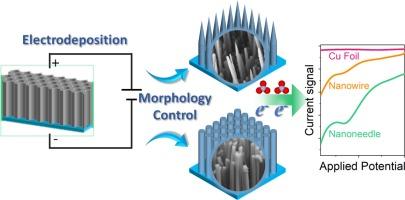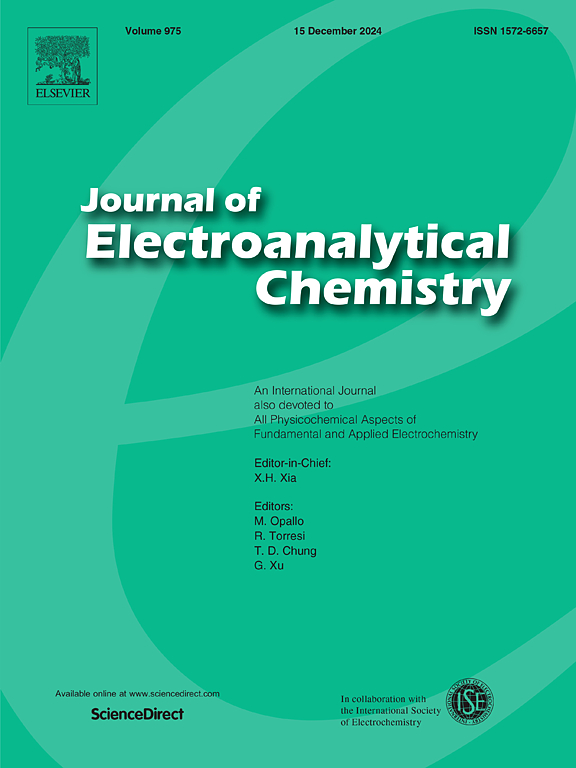Electrodeposition of Cu-based nanoarrays with tailored hierarchical nanostructure and their application for electrochemical nitrate sensing
IF 4.1
3区 化学
Q1 CHEMISTRY, ANALYTICAL
引用次数: 0
Abstract
Excessive nitrate content in the ecosystem has raised environmental concerns as a contaminant in soil and water bodies. Therefore, there is a consistent demand for rapid and continuous detection technologies with simple operational processes. In this work, we present a Cu-based nanoarray fabricated by a template-assisted electrodeposition process. By varying the deposition current density, the nanoarray exhibited a hierarchical nanoneedle structure with a sharp-needle terminal. Structural analysis confirmed that the metallic Cu nanoneedle has a unique crystal structure compared to the control samples of foil or wire structures. The possible deposition mechanism of nanoneedle was discussed based on the initial crystal formation step during electrodeposition. Furthermore, we explored the sensing performance of the Cu nanoarrays through electrochemical nitrate detection by using cyclic voltammetry (CV). The effect of the needle length on sensing performance was evaluated and the 7 μm nanoneedle array showed the highest sensitivity of 1.22 μA μM−1 cm−2 and a wide detection range of 0.25 mM to 16 mM, about 41-fold enhancement compared to the Cu foil. The square-wave voltammetry (SWV) method was further utilized for the low nitrate content detection (0.02 mM to 0.3 mM) and the nanoneedle array achieved an improved sensitivity of 6.99 μA μM−1 cm−2 and an LOD of 26 μM. The interference study indicated a good tolerance to various interference species. Multiple cycle scans and long term stability tests were conducted using the nanoneedle electrode, which maintained 80 % sensing response after 25 scan tests and close to 95 % sensing response after 21 testing days. The nanoneedle electrode also demonstrated sensing capability in analyzing nitrate species in a real water sample (tap water). Our work provides a convenient method to obtain a hierarchical metallic nanostructure, and the Cu-based nanoarrays show potential for sensitive detection of nitrate across a wide range of applications.

具有定制分层纳米结构的铜基纳米阵列的电沉积及其在电化学硝酸盐传感中的应用
生态系统中硝酸盐含量过高,已成为土壤和水体中的一种污染物,引发了环境问题。因此,人们一直需要操作过程简单的快速连续检测技术。在这项工作中,我们介绍了一种通过模板辅助电沉积工艺制作的铜基纳米阵列。通过改变沉积电流密度,纳米阵列呈现出具有尖针末端的分层纳米针状结构。结构分析证实,与金属箔或金属丝结构的对照样品相比,金属铜纳米针具有独特的晶体结构。根据电沉积过程中晶体形成的初始步骤,讨论了纳米针的可能沉积机制。此外,我们还利用循环伏安法(CV)通过电化学硝酸盐检测探讨了铜纳米阵列的传感性能。与铜箔相比,7 μm 纳米针阵列的灵敏度最高,达到 1.22 μA μM-1 cm-2,检测范围广,从 0.25 mM 到 16 mM,提高了约 41 倍。方波伏安法(SWV)进一步用于低硝酸盐含量(0.02 mM 至 0.3 mM)的检测,纳米针阵列的灵敏度提高到 6.99 μA μM-1 cm-2,LOD 为 26 μM。干扰研究表明,该方法对各种干扰具有良好的耐受性。使用纳米针电极进行了多次循环扫描和长期稳定性测试,该电极在 25 次扫描测试后保持了 80% 的传感响应,在 21 个测试日后接近 95% 的传感响应。纳米针电极在分析真实水样(自来水)中的硝酸盐种类时也表现出了感应能力。我们的工作提供了一种获得分层金属纳米结构的简便方法,基于铜的纳米阵列显示了在广泛应用中灵敏检测硝酸盐的潜力。
本文章由计算机程序翻译,如有差异,请以英文原文为准。
求助全文
约1分钟内获得全文
求助全文
来源期刊
CiteScore
7.80
自引率
6.70%
发文量
912
审稿时长
2.4 months
期刊介绍:
The Journal of Electroanalytical Chemistry is the foremost international journal devoted to the interdisciplinary subject of electrochemistry in all its aspects, theoretical as well as applied.
Electrochemistry is a wide ranging area that is in a state of continuous evolution. Rather than compiling a long list of topics covered by the Journal, the editors would like to draw particular attention to the key issues of novelty, topicality and quality. Papers should present new and interesting electrochemical science in a way that is accessible to the reader. The presentation and discussion should be at a level that is consistent with the international status of the Journal. Reports describing the application of well-established techniques to problems that are essentially technical will not be accepted. Similarly, papers that report observations but fail to provide adequate interpretation will be rejected by the Editors. Papers dealing with technical electrochemistry should be submitted to other specialist journals unless the authors can show that their work provides substantially new insights into electrochemical processes.

 求助内容:
求助内容: 应助结果提醒方式:
应助结果提醒方式:


